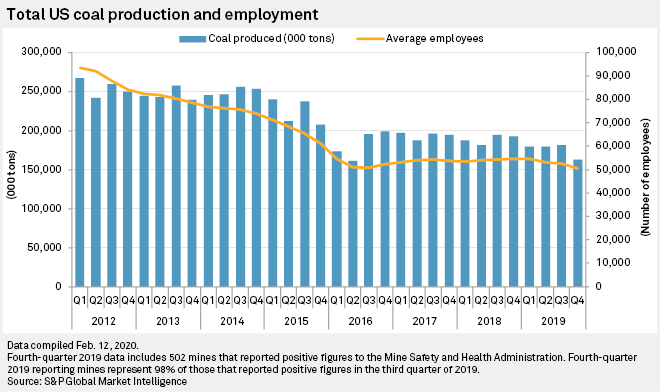US Coal Mining Employment Hits New Low at End of 2019, May Go Lower in 2020

By Taylor Kuykendall and Gaurang Dholakia
February 19, 2020 - U.S. coal mining employment hit a new low in the fourth quarter of 2019 as export demand withered away, leaving miners to return to a domestic market locked in an ongoing secular decline.
The total U.S. average coal mining employment figures fell 4.2% quarter over quarter to 50,361 in the most recent period, an S&P Global Market Intelligence analysis of federal data showed. Coal mining employment has oscillated somewhat but held relatively flat since third quarter 2016. That trend began slipping downward in 2019, and the industry wrapped up the year reporting the lowest average quarterly coal mining employment figure recorded in modern history.

Given where supply and demand fundamentals fall in the sector, 2020 could see those numbers drop even lower.
"Additional supply rationalization is necessary to correct the continuing oversupply situation," Alliance Resource Partners LP CEO Joseph Craft said on the company's fourth-quarter 2019 earnings call. "Alliance anticipates that much of this market correction will occur this year, making 2020 an inflection point for domestic thermal coal producers."
Despite the Trump administration's rhetoric around its actions related to the coal sector and numerous attempts to change the fuel's fate through policy changes, domestic coal demand took a substantial hit from persistently low natural gas prices brought on by developments in shale gas drilling. The International Energy Agency, or IEA, recently noted that the United States recorded the highest sheer drop in coal-fired power generation in 2018, even as total power production increased.
"In the United States, the shale gas boom is coal's undoing," the IEA wrote in its 2019 report on coal. "The federal government and some coal-producing states still provide support for coal power plants, yet coal's destiny in the United States continues to be determined by the shale gas revolution."

While the administration is rolling back environmental restrictions on coal mining and generation, the net effect has not overcome the economics working against the fuel.
In contrast to President Donald Trump's repeated pledge that coal miners were going back to work under his administration, U.S. Department of Energy Secretary Dan Brouillette recently suggested that the administration was not trying to revive the industry. Instead, at least at the DOE, the administration is seeking ways to export new coal-burning technology to other countries, to supplement export opportunities or to find new ways to use coal.
"No one's going to argue with the point that coal, as a percentage of U.S. electricity generation, is declining and will probably continue to decline for some time," Brouillette told the Atlantic Council during a February event. "The efforts that we're undertaking is not to subsidize the industry and preserve their status, if you will, as a large electricity generator, it is simply to make the product cleaner and to look for alternative uses for this product or this commodity."
Trump's arrival to the White House coincided with an uptick in overseas demand for coal. Since the second quarter of 2016, when domestic coal production fell to a record low of 160.9 million tons, U.S. coal tonnage rebounded and held roughly flat. While exports are a relatively small part of the entire U.S. coal market, the temporary rise in demand increased opportunities for operators with access to the seaborne markets.
However, international prices turned sharply in recent months, and total U.S. production in the most recent quarter, at 162.9 million tons, is already flirting with the record low.
"Coal export volumes are likely to continue falling in 2020, leading to significant deterioration in earnings and cash flow generation," Moody's said in a January outlook on the industry.
At the same time, coal plant retirements in the U.S. continue at a rapid pace, shrinking the potential customers available to producers. A recent S&P Global Market Intelligence analysis found that 2019 marked the second-highest level of annual coal capacity retirements in the U.S. since 2015 and already announced closures put 2020 on pace to exceed the level of coal capacity retirements in 2014, 2016 and 2017.
Annual U.S. coal production reported to the U.S. Mine Safety and Health Administration was 703.6 million tons in 2019, a decrease of 6.9% compared to the prior year and the lowest level of annual production in modern U.S. history. The U.S. produced roughly 3.4% fewer tons of coal in 2019 than what companies mined in 2016, the last year of the Obama administration.
Average U.S. coal production declined in the second half of 2019 compared to the first half in major U.S. coal regions such as the Illinois Basin and the Northern Appalachian Basin and the Central Appalachian Basin. The three basins all have access to export markets, and the Appalachian basins both have abundant reserves of metallurgical coal used in steelmaking.
Producers in the Powder River Basin increased production substantially in the second half of 2019, but that follows a significant drop in overall tons produced in the first due to several issues impacting production in the region, including sudden closures related to bankruptcy complications. The area mines primarily thermal coal for domestic power generation and has limited opportunities to reach export markets.
Overall, annual production in the Powder River Basin totaled 294.2 million tons, the lowest reported in recent decades.


